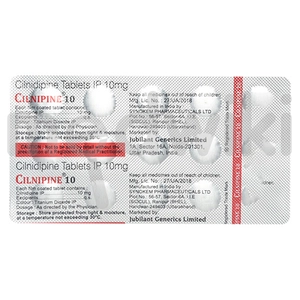cilnipine
Cilnipine 10 Tablet is primarily used to control blood pressure. It operates through dual mechanisms: relaxing blood vessels and managing stress-related chemicals to maintain healthy blood pressure levels.
Cilnidipine blocks calcium entry into blood vessels, reducing their tightness and allowing easier blood flow, which lowers blood pressure. It also interferes with the release of norepinephrine, a stress-related chemical, that prevents blood pressure spikes during stressful situations.
Follow your doctor's instructions regarding the dose and duration. Take this medication with or without food but at a consistent time each day for better results.
Swallow the tablet whole, without chewing, crushing, or breaking it.
Be aware of the potential decrease in blood pressure. Move slowly when transitioning from sitting or lying to standing positions to avoid dizziness or fainting.
Individuals with heart conditions like heart failure or severe aortic stenosis should use cilnidipine cautiously and remain under close medical supervision.
Keep your healthcare provider informed about any other medical conditions, allergies, or medications you are taking.
Possible side effects include headache, nausea, dizziness, palpitations, edema (swelling), abdominal pain, rash, muscle pain, eye pain, tremors, and decreased blood pressure. If you experience any of these symptoms, contact your healthcare provider.
If you miss a dose, take it as soon as you remember. However, if it's almost time for your next dose, skip the missed one and continue with your regular schedule.
Do not take a double dose For guidance on managing missed doses, consult your doctor.
Available in 4 variations

Cilnipine 10 Tablet
strip of 10 tablets

Cilnipine 10mg Tablet 15s
strip of 15 tablets

Cilnipine 5 Tablet 10s
Cilnipine 5 Tablet 10s
strip of 10 tablets

Cilnipine 20 Tablet 10s
Cilnipine 20 Tablet 10s
strip of 10 tablets
Related Faqs

Which is better amlodipine or Cinod?
Both Cinod and amlodipine are commonly prescribed medications for treating high blood pressure and both have proven to be effective in reducing blood pressure effectively However there are some notable differences between the two medications Research has shown that Cinod may offer additional benefits for patients with kidney problems compared to amlodipine Furthermore while amlodipine may have the potential to cause mild ankle swelling Cinod has a lower chance of causing ankle swelling tachycardia and palpitations Ultimately the choice between Cinod and amlodipine will depend on your specific needs and medical history and your doctor will be able to recommend the best option for your individual circumstances

Which is better amlodipine or Ordilan?
Both of these medications have proven to be effective in managing blood pressure and are equally reliable in reducing high blood pressure levels However Ordilan offers an additional advantage for individuals with kidney problems compared to amlodipine Furthermore it has been observed that amlodipine may occasionally result in mild ankle swelling whereas the likelihood of experiencing ankle swelling tachycardia and palpitations is lower with Ordilan Ultimately the choice between these two medications will depend on your specific needs and what your doctor deems most suitable for your condition

What are the side effects of Clinispect?
Clinispect is typically well tolerated although there are instances where it may be accompanied by certain side effects Some individuals may experience common side effects such as headaches dizziness flushing palpitations low blood pressure and stomach problems Additionally it is important to note that increased urination ankle swelling and lethargy are potential side effects that may occur but are not prevalent in all individuals who take this medication If you happen to observe any side effects after consuming Clinispect it is advisable to consult your healthcare provider for further guidance and evaluation It is crucial to address any concerns or potential adverse reactions promptly to ensure your wellbeing while taking this medication

Which is better amlodipine or Retcil?
Both Retcil and amlodipine are commonly prescribed medications for the treatment of high blood pressure These drugs are equally effective in reducing blood pressure levels However there are some notable differences between the two Retcil has been found to be particularly beneficial for patients with kidney problems whereas amlodipine does not possess the same advantage Furthermore amlodipine has a higher likelihood of causing mild ankle swelling as a side effect whereas Retcil has a lower chance of causing this side effect as well as tachycardia and palpitations The choice between these two medications will ultimately be determined by your doctor who will assess your individual needs and select the most appropriate treatment option for you So it is important to consult with your healthcare provider to determine which medication is best suited for your specific condition

What are the side effects of Natocil?
Natocil a commonly prescribed medication is generally known for its good tolerance among patients However as with any medication there can be certain side effects that may arise These side effects though not experienced by everyone can include headaches feelings of dizziness occasional flushing of the skin heart palpitations low blood pressure and gastrointestinal discomfort In some instances individuals may also encounter increased urination swelling of the ankles and a sense of lethargy It is important to note that while these side effects are uncommon they may still occur in certain individuals If you happen to experience any of these side effects while taking Natocil it is advisable to seek prompt medical attention Consulting with your healthcare provider will allow for a thorough evaluation and the necessary steps to address these symptoms effectively Remember the benefits of the medication typically outweigh the potential risks but it is crucial to monitor and address any adverse reactions that may arise Overall Natocil presents a favorable safety profile with minimal side effects however it is essential to prioritize your wellbeing and communicate any concerns to your healthcare professional They can provide personalized guidance and support to ensure your treatment plan remains optimal and any side effects are managed appropriately

Which is better amlodipine or Cilnician?
Both of these medications are commonly prescribed for the treatment of high blood pressure and have proven to be equally effective in reducing blood pressure levels However Cilnician has been found to provide additional benefits for patients with kidney problems compared to amlodipine In terms of side effects amlodipine may occasionally cause mild ankle swelling while Cilnician has a lower risk of causing ankle swelling tachycardia and palpitations The choice between these two medications will ultimately depend on your individual needs and preferences and your doctor will determine which one is most suitable for you
Disclaimer : This information is not a substitute for medical advice. Consult your healthcare provider before making any changes to your treatment . Do not ignore or delay professional medical advice based on anything you have seen or read on Medwiki.
cilnipine
Prescription Required
Manufacturer :
Jubilant Life SciencesComposition :
cilnidipineMRP :
Related Posts

1:15
What is Bird Flu? Symptoms, Prevention, and How It Spreads!

1:15
Easy Home Remedies for Upper Stomach Pain Relief!

1:15
Screening of Autism Spectrum Disorder (ASD): In Children and Adults!

1:15
Autism Spectrum Disorder: What is it and its symptoms!

1:15
White Discharge: What’s Normal and When to Worry?















.svg)

